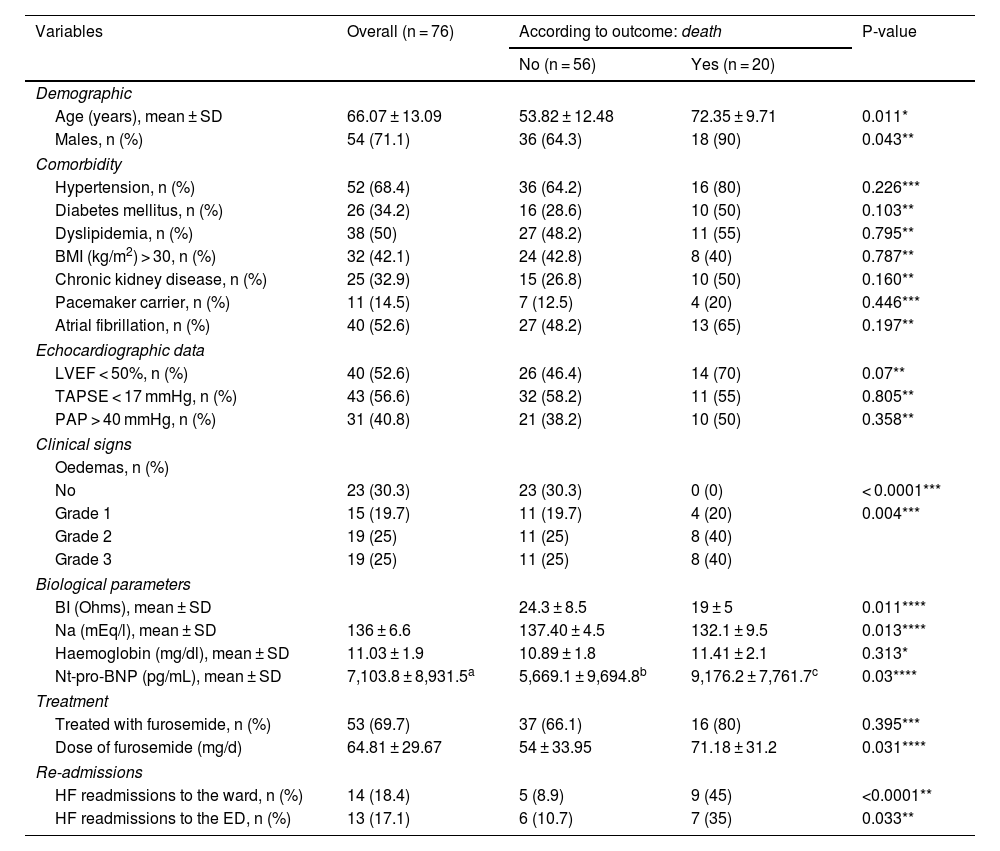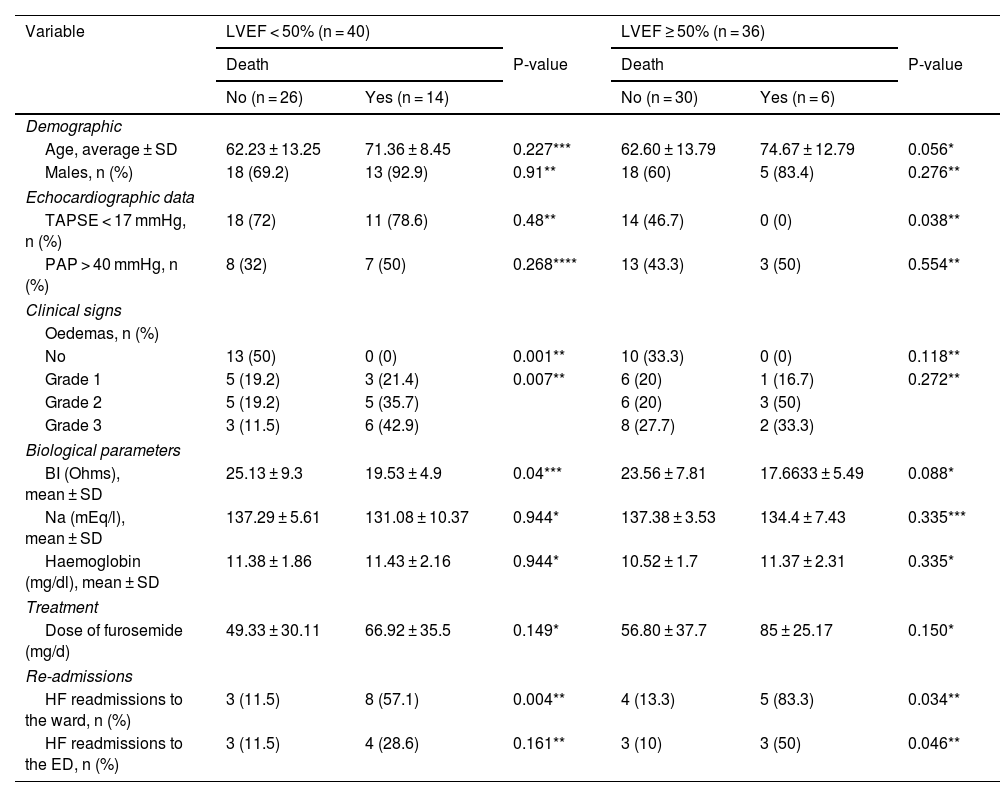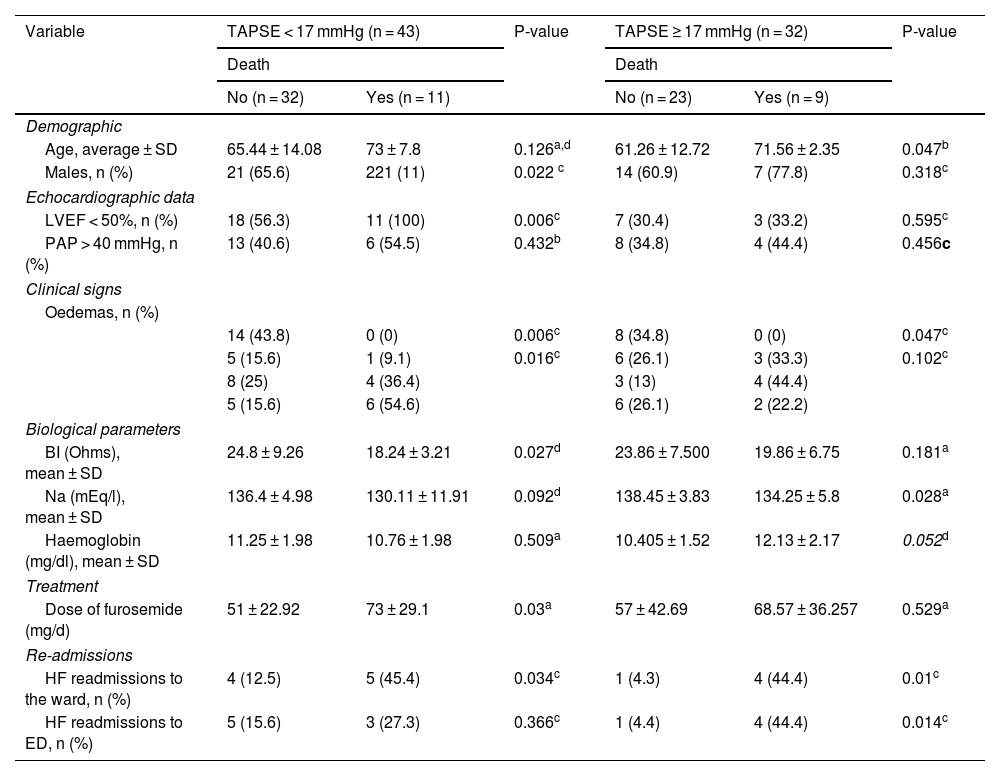The current evaluation of acute heart failure (HF) does not allow an adequate prediction of its evolution. The electrical bioimpedance (BI) allows knowing the state of blood volume, until now only with fixed equipment. We have developed and validated a portable and wireless device to measure BI at the ankle (IVOL). The objective of the study is to know the long-term prognostic value of the point measurement of BI with IVOL in patients with acute HF.
MethodsA prospective cohort study of unselected patients admitted for acute HF in a tertiary hospital. The association between BI and different clinical, analytical and echocardiographic variables on admission and clinical evolution were analyzed.
Results76 patients were included (mean age 66.1 years, 71.1% men, 68.4% hypertensive, 34.2% diabetic, mean NT-ProBNP: 7,103 pg/ml). Of these, 52.6% with non-preserved left ventricular ejection fraction (LVEF) (<50%) and 56.6% with right ventricular (RV) dysfunction. 26.3% died during a mean follow-up of 35.8 months. Survival in patients with BI ≤ 21,8 Ω was lower, globally and in the subgroups of patients without preserved LVEF and with RV dysfunction, p < 0.008). In the multivariate analysis, a BI ≥ 21.8 Ω was an independent survival factor (HR 0.242, 95% CI:0.86−0.681, p = 0.007).
ConclusionsBI values measured with IVOL may be an independent predictor of long-term mortality in patients hospitalized for acute HF. This prognostic value is maintained in patients without preserved LVEF function and with RV dysfunction.
La evaluación actual de la insuficiencia cardiaca (IC) aguda no permite predecir adecuadamente su evolución. La bioimpedancia eléctrica (BI) permite conocer el estado de volemia, hasta ahora solo con equipos fijos. Hemos desarrollado y validado un dispositivo portátil e inalámbrico para medir BI en el tobillo (IVOL). El objetivo del estudio es conocer el valor pronóstico a largo plazo de la medición puntual de la BI con IVOL en pacientes con IC aguda.
MétodosEstudio de cohorte prospectivo de pacientes no seleccionados ingresados por IC aguda en un hospital de tercer nivel. Se analizó la asociación entre BI y diferentes variables (clínicas, analíticas y ecocardiográficos) al ingreso y evolución clínica.
ResultadosSe incluyeron 76 pacientes (edad media 66,1 años, 71,1% varones, 68,4% hipertensos, 34,2% diabéticos, NT-ProBNP medio: 7.103 pg/mL). De ellos, 52,6% con fracción de eyección del ventrículo izquierdo (FEVI) no preservada (<50%) y 56,6% con disfunción del ventrículo derecho (VD). 26,3% fallecieron durante un seguimiento medio de 35,8 meses. La supervivencia en pacientes con BI ≤ 21,8 Ω fue menor, globalmente, y en los subgrupos de pacientes sin FEVI preservada y con disfunción del VD, p < 0,008). En el análisis multivariante una BI ≥21,8 Ω fue un factor independiente de supervivencia (HR 0,242, IC95%:0,86−0,681, p = 0,007).
ConclusionesLos valores de BI medidos con IVOL pueden ser un predictor independiente de mortalidad a largo plazo en pacientes hospitalizados por IC aguda. Este valor pronóstico se mantiene en pacientes con FEVI no preservada y con disfunción ventricular derecha.












